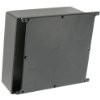-
Intro Video
08/25/2015 at 07:36 • 0 comments -
$80 Lenovo Tab 2's are great!
08/17/2015 at 04:21 • 0 commentsI have a Lenovo A1000 tablet that I got about a year ago for ~$80. It works fine for ebooks and 480p/720p videos, but is really too slow for web browsing. The Tab 2's are a great buy for the money. Given the recent coverage of "The realities of a $50 smartphone," the reality of a $80 tablet is that the display isn't nearly as good as a Samsung Tab 4, but it's about half the price and runs Tower and FireFox just fine.
-
My New Robotic Friends
08/13/2015 at 01:27 • 0 comments![]()
Rovers are a lot like PHP libraries. Developers start by scratching a personal itch. But, in the end, they are all broken in their own unique way. So, I've decided to use rover platforms from SuperDroid Robots, who employs a dozen professional engineers and has been building robots for 25 years. I'll focus my efforts on putting my new friends to work.
-
They're Here!
08/13/2015 at 00:30 • 0 comments![]()
-
BUD Industries Makes Great Boxes
08/11/2015 at 16:14 • 0 commentsOr, "enclosures." Good design, well made, inexpensive.Just search Amazon for "BUD Industries Aluminum Econobox"
![]()
-
SV1AFN's $30 RF Switch
08/11/2015 at 02:50 • 0 commentsHMC784 - 10W RF SPDT Switch, LF to 4000 MHZ (4 GHZ), 30 dB Isolation, 15-40 nSec switching times, Very Low DC current - Good IMD3 (+60 dBm)
https://www.sv1afn.com/hmc784_trswitch.html
This uses the same chip as the eval board from DigiKey for $138.75 and includes a hex inverter for single wire control!
Plus, the DC blocking capacitors are unpopulated. So, you can select the best values for the frequency you are using. Here is a brief discussion on picking the best values for the caps.
-
Stopping Pollution Before It Starts
08/06/2015 at 04:41 • 0 commentsAn anonymous visitor to my table at the Detroit Maker Faire mentioned that he worked for an undisclosed company that was using proprietary methods for locating valves in underground oil pipelines. These valves were then removed before they sprung a leak.
He said the company considered using ground penetrating radar, but decided against it because of the cost ("$50,000 to $100,000 per system").
I wonder how many potential problems could be located and mitigated with an unmanned ground penetrating radar system that costs 20% of current manned systems?
I'll probably need to increase the frequency to be able to see the target signature of valves in a 3" pipe at "backhoe depth." But, it's on my growing list of targets.
First, I'm going after the elephant in the room.
-
NAVIO+ is neat, but expensive
08/05/2015 at 15:55 • 0 comments"Navio+ is an improved version of Navio autopilot shield for Raspberry Pi A+/B+. It was designed both for your own custom robotic projects and as a platform for Linux version of APM (ArduPilot). Navio+ eliminates the need in multiple controllers onboard making development easier and increasing robustness."
But, at $168 the NAVIO+, $12 for the GPS antenna and $24 for the power module, it's three times the cost of a APM 2.6.
-
mechanical speed reduction
07/31/2015 at 23:50 • 0 comments"choosing the best [mechanical] reduction ratio is the single most important factor in determining how well the motor will work in a particular application."
"Do not rely on electronic speed reduction to do the job of a mechanical speed reducer."
AmpFlow whitepaper:
-
Choosing a Vendor, Letting Go
07/30/2015 at 18:18 • 0 commentsJim Summers recommended two battery suppliers: EM3EV and ElectricRider.
I discounted EM3EV because they don't have exactly what I need. They have a "Request a quote" option, but are located in Hong Kong and don't list a phone number on their web site. When developing a product, it's often important to be able to talk with someone on the phone.
ElectricRider has what I need. But, when I called the good people down in Texas and asked about a solar charge controller, they said their controller works on 120 volts and if my "solar panel puts out 120 volts, it'll work fine." *facepalm*
I consulted the great AI known as Google and found Bioenno Power whose "products are trusted and employed internationally and domestically by a wide customer base ranging from amateur model makers using our batteries for RC applications to professional aviators trusting our batteries to power critical avionics and Ham Radio operators." And, they sell solar charge controllers for their LiFePO4 batteries. Wow! Sounds like a perfect fit.
So, I called them. They were very pleasant and helpful, but insisted that 24 volt batteries need 24 volts of solar power. Inexpensive, small form factor, 100 watt (C/5-ish for 24 volt, 20 amp-hour batteries) pretty much don't exist.
Not to be deterred in my quest, I consulted Google a few more times and found a vendor in California that sells a device that does what I want. But, it's manual is in poorly translated Chinese, which doesn't inspire confidence.
So, I've decided to let go of my desire for a solar panel on my rover. This will allow for a smaller, lighter rover that isn't top heavy. I can charge the batteries from a pair of ground mounted 12 volt panels. I could use a DC/DC converter to step up the 12 volt solar panel to 24 volts for the charge controller. But, this is going past the design goal of "keeping it simple."
Moral of the story: follow your heart. It may not lead you to what you see in your dreams, but it may lead you to a better vendor of LiFePO4 batteries.
 Glenn Powers
Glenn Powers

